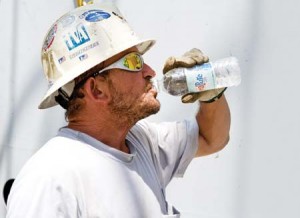A lot of time and effort is spect in educating workers in scaffolding training and fall protection that it is easy to forget that the summer season can greatly affect the work as well. As we approach the summer season, where some parts of the country experience extreme temperature highs, it’s important to keep in mind three things: water, rest, and shade.
 To prevent heat illnesses like heat stroke, OSHA has provided numerous educational resources for workers and employers to learn from. Here are three basic ways to stay efficient in the summer heat:
To prevent heat illnesses like heat stroke, OSHA has provided numerous educational resources for workers and employers to learn from. Here are three basic ways to stay efficient in the summer heat:
1. As mentioned above, enourage water breaks and shade. Doing so allows the body to recuperate from the sun’s glaring rays. In addition, workers should avoid alcohol, caffeine, and heavy meals, which makes you feel weighed down.
2. Learn how to use the heat index to your advantage and be aware of humidity. The heat index is how it feels outside, so it takes into account not just the temperature, but also the humidity. Humid days slow the evaporation of sweat, which in turn prevents workers from staying and feeling cool. When your body doesn’t sweat enough, it causes your body temperature to rise.
3. Be aware of newer workers. OSHA has determined that newer workers are the highest risk at heat related illnesses, since they have not yet been physically acclimated to the work.
Workers new to outdoor jobs are generally most at risk for heat-related illnesses. For example, Cal/OSHA investigated 25 incidents of heat-related illness in 2005. In almost half of the cases, the worker involved was on their first day of work and in 80% of the cases the worker involved had only been on the job for four or fewer days. That’s why it’s important to gradually increase the workload or allow more frequent breaks to help new workers and those returning to a job after time away build up a tolerance for hot conditions. Make sure that workers understand the risks and are “acclimatized”.
There are three main types of heat illnesses that you should look out for, including heat cramps, heat exhaustion, and heat stroke.
Heat cramps deal with the muscles lacking adequate fluid in order for them to function. This is a result of both lack of intake of fluids, as well as sweating in the hot summer sun. Workers will experience tightness of muscles and cramps, similar to a leg cramp, but in all extremities.
Heat exhaustion is slightly more serious, but can often be taken care of of allowing the person to rest and rehydrate. Workers will experience heat cramps, nausea, feelings of fatigue, unquenchable thirst, and general weakness. They also may feel confusion and dizziness.
Heat stroke is the most serious of all of them and can come on quickly, and be life threatening. Heat Stroke may have similar symptoms of heat exhaustion, but will also include symptoms of a fast heart rate, a high fever, blood in the urine, and shortness of breath.
If you think your workers have any of these symptoms, get them out of the heat, somewhere cool and shaded. Increase fluids (non-caffeinated) and apply cool cloth to their skin to help cool them down. If symptoms persist, or they have symptoms of heat stroke, call emergency services right away.
For more information on all the ways you can protect your workers, contact us today.



